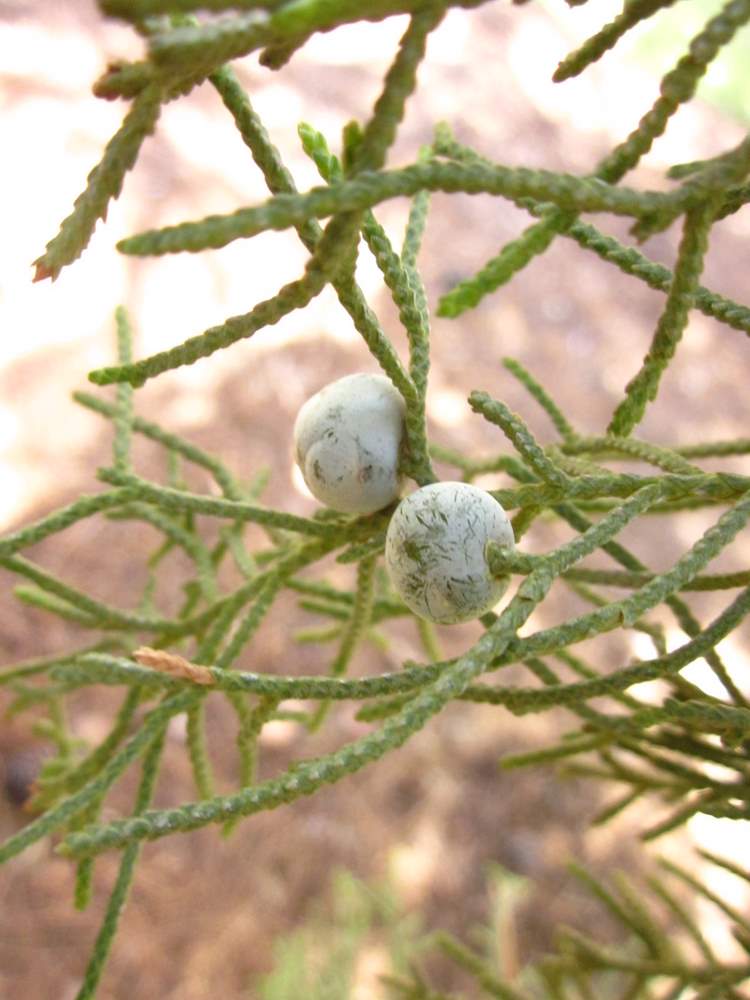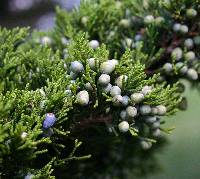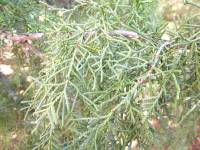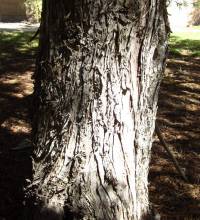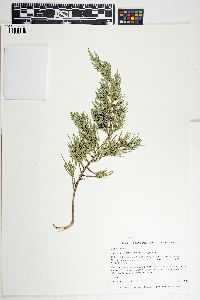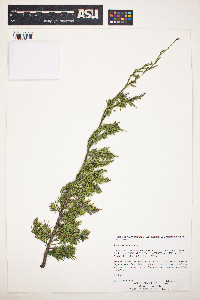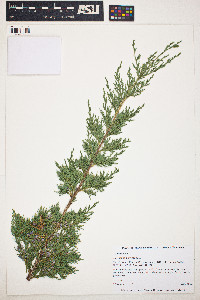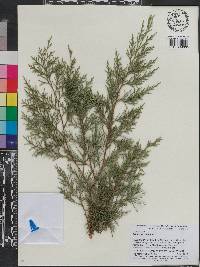|
|
|
|
Family: Cupressaceae
eastern redcedar
|
Trees dioecious, to 30 m, single-stemmed; crown narrowly erect to conical, round, or flattened. Bark brown, exfoliating in thin strips, that of small branchlets (5--10 mm diam.) smooth, that of larger branchlets usually not exfoliating in plates. Branches pendulous to ascending; branchlets generally erect, sometimes lax to flaccid, 3--4-sided in cross section, ca. 2/3 or less as wide as length of scalelike leaves. Leaves green but sometimes turning reddish brown in winter, abaxial gland elliptic or elongate, conspicuous, exudate absent, margins entire (at 20´ and 40´); whip leaves 3--6 mm, not glaucous adaxially; scalelike leaves 1--3 mm, overlapping by more than 1/4 their length, keeled, apex obtuse to acute, spreading. Seed cones maturing in 1 year, of 1 size, generally with straight peduncles, globose to ovoid, 3--6(--7) mm, blue-black to brownish blue when mature, glaucous, soft and resinous, with 1--2(--3) seeds. Seeds 1.5--4 mm. Tree 10 - 20 m tall, trunk 20 cm - 1 m in diameter Leaves: scale-like or needle-like, green to bluish or yellowish green, persisting for five to six years. Scale-like leaves are common on older trees and are overlapping, 2 - 4 mm long, egg-shaped with pointed to rounded tip and may have glands on the back. Needle-like leaves are common on young trees and quickly growing shoots of older trees and are borne in lose whorls of two to three, often with white lines above, 5 - 7 mm long with a spiny tip. Foliage sometimes turning bronze to yellowish brown in winter. Bark: light reddish brown, peeling in narrow shredded strips. Twigs: bluish green to reddish brown, smooth. Buds: very small, hidden by the leaves. Form: irregular, pyramidal to rounded or flat-topped with a dense crown. Cones: unisexual, with separate pollen and seed cones produced on different trees (dioecious), rarely on the same tree (monoecious), near tips of branches. Pollen cones: 2.5 - 3 mm long, oblong to egg-shaped, with four to six scales, each scale containing four to five spherical yellow pollen sacs. Seed cones: made of thick bluish scales fusing to become nearly spherical and berry-like, borne on short straight stalks near ends of branches, green changing to dark blue with a whitish waxy coating (glaucous), 5 - 7 mm in diameter, maturing in one season, resinous, each containing one or two egg-shaped seeds. Pollination occurs from April to May. Similar species: Thuja occidentalis is easily distinguished from the junipers found in the Chicago Region. It has flattened branches, all scale-like leaves, and woody cones. The junipers of the region all have berry-like cones and branches that are not flattened. Juniperus communis has all needle-like leaves. Juniperus horizontalis is trailing with erect branches, has mostly scale-like leaves, and the cones are on recurved stalks. Juniperus virginiana is represented by one variety in the Chicago Region. See link below for further information. Habitat and ecology: Dry woods, fields, cliffs, and dry calcareous sites. Occurence in the Chicago region: native Notes: Although the common name is eastern red cedar, this species is not a true cedar (Cedrus sp.). The wood of J. virginiana is used to make fence posts, pencils, shingles, and log cabins. A scented oil in the wood is disliked by moths, so the wood is commonly used in closets and clothing chests. Female cones are used to flavor gin. This species is a host for cedar-apple, -hawthorn, and -quince rust diseases. It hybridizes with J. horizontalis. Etymology: Juniperus is the Latin name for juniper. Virginiana means "from Virginia." Author: The Morton Arboretum Shrub or tree with a dense crown, to 20 m; juvenile lvs subulate, pungent, 5-7 mm, spreading or ascending; lvs of adult branches scale-like, appressed, ovate or lance-ovate, 2-4 mm, obtuse or subacute, convex on the back; cones terminal on short, straight peduncles, subglobose, blue-glaucous, 5-7 mm thick; seeds 1 or 2, pitted toward the base. In a variety of soils, esp. in dry, calcareous sites; s. Me. and s. Que. to N.D., s. to Ga., nw. Fla., and Tex. Two weakly distinguished vars.: Var. virginiana, occurring from Va. to s. Mo. and southward, has a relatively broad, ovoid crown with widely spreading branches, and the seeds are strongly pitted. Var. crebra Fernald, the more northern phase, has a narrowly spire-shaped crown with distinctly ascending branches, and the seeds are only obscurely pitted. Gleason, Henry A. & Cronquist, Arthur J. 1991. Manual of vascular plants of northeastern United States and adjacent Canada. lxxv + 910 pp. ©The New York Botanical Garden. All rights reserved. Used by permission. |


